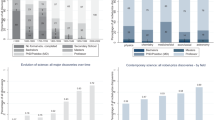Abstract
I examine whether the professionalization of science, a process that unfolded between 1600 and 1899, afforded better opportunities for young scientists to make significant discoveries. My analysis suggests that the professionalization of the sciences did make it a little easier for scientists to make significant contributions at a younger age. But, I also argue that it is easy to exaggerate the effects of professionalization. Older and middle age scientists continued to play an important role in making significant discoveries throughout the history of modern science.
Similar content being viewed by others
References
Ben-David, J. (1984/1971). The Scientist’s Role in Society: A Comparative Study. Chicago: University of Chicago Press.
Biagioli, M. (1993). Galileo Courtier: The Practice of Science in the Culture of Absolutism. Chicago: University of Chicago Press.
Biagioli, M. (2006). Galileo’s Instruments of Credit: Telescopes, Images, Secrecy. Chicago: University of Chicago Press.
Cole, S. (1979). Age and scientific productivity, American Journal of Sociology, 84: 958–977.
Cunningham, A., P. Williams (1993). Decentring the “Big Picture”: The origins of modern science and the modern origins of science, British Journal for the History of Science, 26: 407–432.
Dennis, W. (1956). Age and productivity among scientists, Science, 123: 724–725.
Diamond, A. M. (1980). Age and acceptance of cliometrics, Journal of Economic History, 40: 838–841.
Dibner, B. (1980). Heralds of Science: as represented by two hundred epochal books and pamphlets in the Dibner Library, Smithsonian Institution, 25th Anniversary edition, preface and notes by B. Dibner, introduction by R. P. Multhauf. Norwalk CT and Washington DC: Burndy Library and Smithsonian Institution.
Dietrich, A., N. Srinivasan (2007. The optimal age to start a revolution, Journal of Creative Behavior, 41(1): 54–74.
Garvey, W. D., K. Tomita (1972). Continuity of productivity by scientists in the years 1968–1971, Science Studies, 2: 379–383.
Horner, K., J. P. Rushton, P. A. Vernon (1986). The relation between aging and research productivity of academic psychologists, Psychology of Aging, 1: 319–324.
Hull, D. L., P. D. Tessner, A. M. Diamond (1978). Planck’s Principle, Science, 202 (17 November 1978): 717–723.
Kanazawa, S. (2003). Why productivity fades with age: The crime-genius connection, Journal of Research in Personality, 37: 257–272.
Kuhn, T. S. (1996). The Structure of Scientific Revolutions, Third edition. Chicago: University of Chicago Press.
Kuhn, T. S. (2000). The Road Since Structure: Philosophical Essays, 1970–1993, with an Autobiographical Interview. Chicago: University of Chicago Press.
Lehman, H. C. (1953). Age and Achievement. Princeton: Princeton University Press.
Mccann, H. G. (1978). Chemistry Transformed: The Paradigmatic Shift from Phlogiston to Oxygen. Norwood: Ablex, Norwood.
Messeri, P. (1988). Age differences in the reception of new scientific theories: the case of plate tectonics theory, Social Studies of Science, 18: 91–112.
Nitecki, M. H., J. L. Lemke, H. W. Pullman, M. E. Johnson (1978). Acceptance of plate tectonic theory by geologists, Geology, 6: 661–664.
Over, R. (1982). Is age a good predictor of research productivity?, Australian Psychologist, 17: 129–139.
Rappa, M., K. Debackere (1993). Youth and scientific innovation: The role of young scientists in the development of a new field, Minerva, 31: 1–20.
Simonton, D. K. (2004). Creativity in Science: Chance, Logic, Genius, and Zeitgeist. Cambridge: Cambridge University Press.
Simonton, D. K. (1997). Creative productivity: A predictive and explanatory model of career trajectories and landmarks, Psychological Review, 104: 66–89.
Stern, N. (1978). Age and achievement in mathematics: A case-study in the sociology of science, Social Studies of Science, 8: 127–140.
Stewart, J. A. (1986). Drifting continents and colliding interests: A quantitative application of the interests perspective, Social Studies of Science, 16: 261–279.
Wray, K. B. (2003). Is science really a young man’s game? Social Studies of Science, 33(1): 137–149.
Wray, K. B. (2004). An examination of the contributions of young scientists in new fields, Scientometrics, 61(1): 117–128.
Author information
Authors and Affiliations
Corresponding author
Rights and permissions
About this article
Cite this article
Brad Wray, K. Did professionalization afford better opportunities for young scientists?. Scientometrics 81, 757–764 (2009). https://doi.org/10.1007/s11192-008-2254-x
Received:
Published:
Issue Date:
DOI: https://doi.org/10.1007/s11192-008-2254-x




